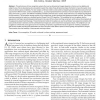Free Online Productivity Tools
i2Speak
i2Symbol
i2OCR
iTex2Img
iWeb2Print
iWeb2Shot
i2Type
iPdf2Split
iPdf2Merge
i2Bopomofo
i2Arabic
i2Style
i2Image
i2PDF
iLatex2Rtf
Sci2ools
PAMI
2006
2006
Matching 2.5D Face Scans to 3D Models
The performance of face recognition systems that use two-dimensional images depends on factors such as lighting and subject's pose. We are developing a face recognition system that utilizes three-dimensional shape information to make the system more robust to arbitrary pose and lighting. For each subject, a 3D face model is constructed by integrating several 2.5D face scans which are captured from different views. 2.5D is a simplified 3D (x, y, z) surface representation that contains at most one depth value (z direction) for every point in the (x, y) plane. Two different modalities provided by the facial scan, namely, shape and texture, are utilized and integrated for face matching. The recognition engine consists of two components, surface matching and appearance-based matching. The surface matching component is based on a modified Iterative Closest Point (ICP) algorithm. The candidate list from the gallery used for appearance matching is dynamically generated based on the output...
| Added | 14 Dec 2010 |
| Updated | 14 Dec 2010 |
| Type | Journal |
| Year | 2006 |
| Where | PAMI |
| Authors | Xiaoguang Lu, Anil K. Jain, Dirk Colbry |
Comments (0)

